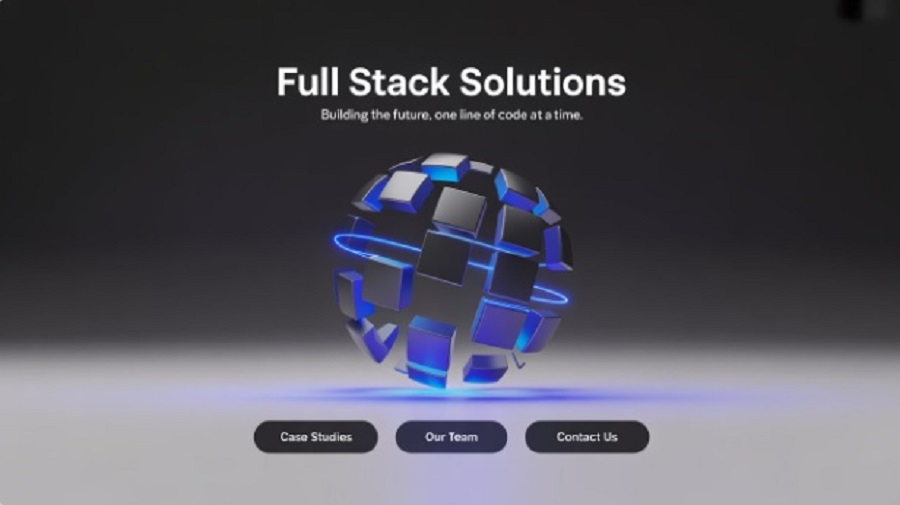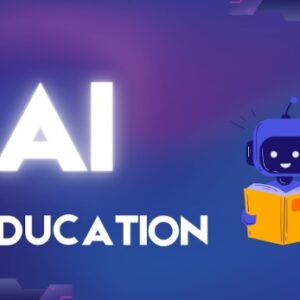
Imagine a small startup with no engineering team shipping a web app in weeks. In early 2025, a UK product designer did just that – she built a full B2B SaaS in under two weeks entirely with AI assistance. This isn’t sci-fi:
AI has become an everyday coding companion. According to a recent report, generative AI enables developers to complete coding tasks up to twice as fast, and most developers (76%) now use or plan to use AI tools in their workflow.
For businesses planning to launch scalable web apps, Full Stack Development Services remain essential. They combine frontend and backend expertise to deliver production-ready solutions—now enhanced with AI for even faster results.
AI on the Frontend: From Sketch to Screen
On the frontend, AI is like a design assistant and code co-pilot.
For example, tools like Builder.io’s Visual Copilot or Figma plugins can convert designs to React, Vue, or Flutter code in one click.
AI assistants also help write UI code. GitHub Copilot (an AI pair programmer) can autocomplete HTML or CSS from comments, and Replit’s Ghostwriter can “automagically complete the code you’re working on”. These features let designers create UI components without writing every line by hand.

AI also boosts front-end testing and debugging. Platforms like LambdaTest use AI to generate and run UI tests at scale. Meanwhile, Copilot or similar tools can suggest fixes for JavaScript errors or even automatically find and patch common bugs during pull requests.
In sum, AI can generate a complete front-end prototype from a description, then test and refine it automatically, letting teams iterate on UI faster and more confidently.
AI on the Backend: Smarter Servers and APIs
In the backend, AI writes much of the boilerplate code that used to take days.
Need a REST API or database migration? You can ask an AI assistant to generate it. For example, GitHub Copilot will “suggest lines or whole blocks of code” for server routes or database queries, based on your comments.
Some platforms, like Bolt.new (by StackBlitz), even let you describe an entire app in chat and handle setup, from Node.js backend to React frontend. And tools like Lovable can take a natural-language specification and spit out a complete web app with authentication, database tables, and payment integration.
Imagine telling AI, “generate a MongoDB schema for a blog post and an API endpoint to query posts”. The AI will write the JSON schema and server code for you. It can integrate third-party services, too. In short, AI can bootstrap full backend systems (servers, functions, databases) from high-level prompts.
AI in DevOps: Automation and Monitoring
On the DevOps side, AI is streamlining testing, deployments, and monitoring. Continuous Integration/Deployment pipelines can be AI-enhanced.
For example, GitHub Copilot suggests YAML for GitHub Actions and can automate release workflows. Copilot’s makers note it “enhances aspects of CI/CD workflows” and indirectly cuts developer effort. Testing pipelines use AI to prioritize and fix failures: tools like LambdaTest use AI to identify flaky tests and suggest fixes. Containerization and cloud infrastructure can also be AI-assisted: you might describe your deployment needs and let AI generate Kubernetes configs or Terraform scripts.
Cloud platforms themselves are embedding AI. Vercel’s 2024 updates added an “AI marketplace” where you can plug in pretrained models (for search, translations, Q&A, etc.) into your web app instantly.
Similarly, services like AWS CodeWhisperer generate AWS-focused backend code and security checks automatically. On the monitoring side, AI-driven tools can analyze logs and performance metrics for anomalies faster than humans.
In practice, this means developers spend less time on repetitive DevOps chores and more on improving service quality and new features.
Top 10 Key AI Tools, 2025
Developers today use a wide array of AI-powered tools. Some big names include:
- GitHub Copilot – An AI pair-programmer that suggests code in your IDE (VS Code, etc.), completing functions or classes based on context. It works for frontend, backend, and even DevOps scripts.
- OpenAI ChatGPT – A general AI chatbot that can answer coding questions, generate snippets in dozens of languages, and even help with documentation or system design.
- Replit Ghostwriter – An in-browser AI assistant integrated into the Replit IDE. It can autocomplete code, explain code in plain English, and transform code.
- Vercel AI (v3.0 SDK) – Vercel’s AI toolkit for Next.js and React apps. With this SDK, front-end UIs can call AI models as easily as database queries.
- LambdaTest / KaneAI – AI-driven testing platforms. LambdaTest’s AI-powered execution (called HyperExecute) claims test runs 70% faster than traditional grids, and its “KaneAI” agent can create and debug tests from plain English.
- Cursor – A newer AI-first code editor (based on VS Code) lets you chat with your codebase. You can ask it to refactor across files or explain complicated logic. Developers often describe it as moving from “assistant” to “active collaborator”.
- Bolt.new – A StackBlitz project lets you “prompt, run, edit, and deploy” full-stack apps entirely in the browser. You simply tell it what app you want, and it sets up the framework, backend, and frontend for you.
- Lovable.dev – A no-code/low-code AI platform. You describe the app in chat and Lovable generates the front end, back end (often using Supabase), and even connects services like Stripe.
- Cursor & Windsurf – Cutting-edge “AI IDE” projects. For example, Windsurf’s “Cascade” agent can scan an entire codebase and perform multi-step edits (like migrating an API across services) autonomously.
- Generative UI tools – Many plugins and apps transform design files into code. For instance, Builder.io’s “Visual Copilot” can convert Figma designs to React, Vue, Flutter or even plain HTML/CSS with one click (supporting Tailwind, Svelte, Angular, etc.)
Please note: This is not an exhaustive list – new AI dev tools emerge monthly. But the trend is clear: there are AI helpers for almost every part of development.
Teams, Speed, and Collaboration in the AI Era
AI is not replacing programmers, but acting as a tireless teammate. According to a LeadDev report, experts now expect developers to “engage in a conversation with their platforms” and leverage AI suggestions routinely.
As one AI champion put it, future teams will “start projects a lot faster, accomplish much more in less time, and overcome challenges”. In fact, a 2023 McKinsey study says developers using generative AI shaved their coding time in half on many tasks.
Roles shift: Junior coders or designers can now do more, while senior engineers spend time reviewing AI output and defining architecture. In many teams, one person might focus on writing effective prompts (“prompt engineering”) while another integrates the results.
Collaboration can also improve – AI-generated draft pull requests or documentation give team members a head start. Despite the power of AI, 70% of devs say AI is not a threat to their job, and many see it as extended help.
As OutSystems VP Joe Ghattas notes, “Fears around AI taking developers’ jobs will fade away and AI will be seen as a colleague who deserves trust, but also requires robust control”.
In short, AI is giving teams superpowers – they can try ideas, write code, and fix bugs faster than ever, as long as they coordinate and review each other’s AI-aided work.
AI Cautions: Bugs, Debt, and Ethics
AI can make mistakes that humans wouldn’t. Research shows that code generated by AI often has unique bugs and security issues.
AI-generated code is also more prone to duplication and technical debt. In one report, AI-powered development led to an 8× increase in duplicated code blocks (violating the “don’t repeat yourself” principle). This means teams must budget extra time for code review and refactoring and avoid pasting AI output.
Quality assurance becomes critical. AI doesn’t automatically test or debug – it often omits corner cases or produces incomplete logic. Developers must carefully review and test AI-written code.
In StackOverflow’s 2024 survey, 79% of developers were worried about misinformation or disinformation in AI results, and 65% were concerned about source attribution.
In short, AI is a powerful tool but still requires human oversight. Teams should use it to assist – to draft code, generate tests, even refactor – but not blindly ship AI output..
The New Reality of Development
By 2025, the typical development workflow will be more “AI-assisted” than ever. Developers and AI agents work side-by-side: AI handles the grunt work of coding, testing, and deployments, while humans plan, integrate, and ensure quality.
This shift is also transforming Software Development Services, enabling teams to deliver faster, smarter, and more efficient solutions than ever before.
The bottom line: AI is radically transforming full-stack development. When used wisely, AI can be an asset: it frees us from tedium and unlocks creativity. But like any powerful tool, it demands responsibility.
In the hands of developers who test, review, and guide it properly, AI is set to make 2025 one of the most exciting years ever for software creation.
Author Profile
- I am the owner of the blog readree.com. My love for technology began at a young age, and I have been exploring every nook and cranny of it for the past eight years. In that time, I have learned an immense amount about the internet world, technology, Smartphones, Computers, Funny Tricks, and how to use the internet to solve common problems faced by people in their day-to-day lives. Through this blog, I aim to share all that I have learned with my readers so that they can benefit from it too. Connect with me : Sabinbaniya2002@gmail.com
Latest entries
 BlogDecember 20, 2025AI Personalized Learning: The End of Traditional Classroom Teaching?
BlogDecember 20, 2025AI Personalized Learning: The End of Traditional Classroom Teaching? How ToDecember 9, 2025How to Increase Bajaj Finserv EMI Network Card Limit
How ToDecember 9, 2025How to Increase Bajaj Finserv EMI Network Card Limit ArticleOctober 23, 2025How to Use Rotating Residential Proxies
ArticleOctober 23, 2025How to Use Rotating Residential Proxies ArticleOctober 19, 2025Why You Should Use Geo-Targeted Proxies for Web Scraping
ArticleOctober 19, 2025Why You Should Use Geo-Targeted Proxies for Web Scraping